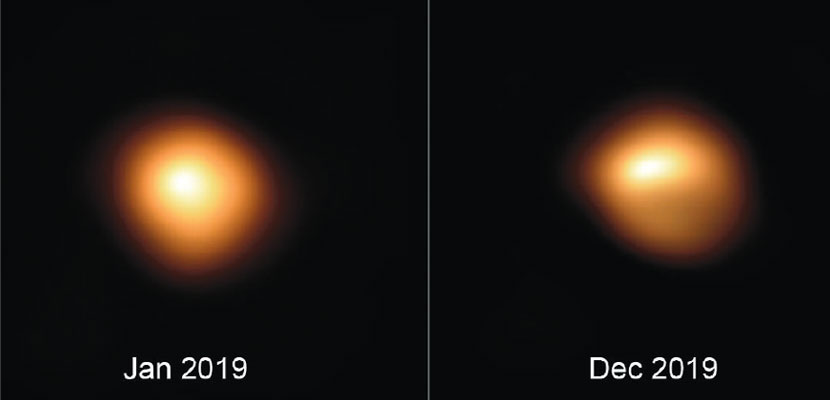
This Article From Issue
May-June 2020
Volume 108, Number 3
Page 142
In this roundup, managing editor Stacey Lutkoski summarizes notable recent developments in scientific research, selected from reports compiled in the free electronic newsletter Sigma Xi SmartBrief.
Dust Causes Betelgeuse to Dim
Stargazers hoping to witness a supernova may be in for a disappointment. Astronomers Emily M. Levesque of the University of Washington and Philip Massey of the Lowell Observatory argue that the dimming of Betelgeuse (a star in the constellation Orion) is due to stellar dust blocking the light rather than the star reaching the end of its life. Levesque and Massey used optical spectrophotometry to measure the temperature of the star and found that it was approximately 25 kelvins cooler than in 2004. If the star itself were growing significantly dimmer, then its temperature would have dropped much more. Red supergiant stars, such as Betelgeuse, can periodically slough off an outer layer of material as part of their normal life cycle. This material then condenses into a cloud of dust, which can prevent light from escaping. This theory is reinforced by recent increases in brightness. Although it has not yet returned to its original glow, it seems that Betelgeuse may stick around a while longer.

ESO / M. Montargès et al.
Levesque, E. M., and P. Massey. Betelgeuse just isn’t that cool: Effective temperature alone cannot explain the recent dimming of Betelgeuse. arXiv:2002.10463v1 (February 24).
Fish Embryos Can Pause Aging
African turquoise killifish can stop their embryonic development for months or even years as they await more favorable conditions, and they do not age during this period. Geneticists have discovered that this process, called diapause, is not passive: The fishes’ cells remain active, repressing their metabolism while maintaining muscle health. When the embryos restart their development, their growth, fertility, and life spans are comparable to those of killifish that did not undergo diapause. The process is regulated by the chromobox 7 gene; in tests of fish without the gene, embryos could not stay in diapause for as long, and their muscles deteriorated quickly. African turquoise killifish live in transient ponds in Mozambique and Zimbabwe that dry up and then refill seasonally. The ability to halt killifish development and aging for as long as two years enables them to wait out the dry seasons until the rains return.
Hu, C.-K., et al. Vertebrate diapause preserves organisms long term through Polycomb complex members. Science doi: 10.1126/science.aaw2601 (February 21).
Acoustics of Bursting Bubbles
The sound of a bubble popping can reveal the mechanisms behind the explosion. A team at the Sorbonne Université in Paris employed aeroacoustics to study the sound of soap bubbles as they burst. They used an array of sensors to capture the hydrodynamic event and were able to quantitatively identify stressors that caused the bubble to burst. Bubbles are well-tread territory in the field of fluid dynamics, but previous studies have relied on high-speed video to visually examine the growing and popping globes. The use of aeroacoustics is proof-of-concept that many of the elements observed in those videos can also be identified aurally. The aeroacoustic techniques can expand our understanding of how bubbles pop and may provide avenues for studying explosions that we can hear but not see.
Bussonnière, A., A. Antkowiak, F. Ollivier, M. Baudoin, and R. Wunenburger. Acoustic sensing of forces driving fast capillary flows. Physical Review Letters doi: 10.1103/Phys RevLett.124.084502 (February 27).
Warm-Blooded Dinosaurs
Fossilized eggshells reveal that all major groups of dinosaurs were endothermic (warm-blooded). This evidence is another link between the prehistoric animals and birds. An international team of geologists analyzed the chemical bonds in 75-million-year-old eggshell fragments for evidence of the temperature of the dinosaurs that laid the eggs. In all three major dinosaur groups (Sauropodomorpha, Theropoda, and Ornithischia) they found that the mothers were consistently warmer than their environment, indicating that the animals metabolically regulated their temperature. The findings support the theory that birds evolved from dinosaurs and are another step away from the previous assumption that dinosaurs were prehistoric lizards.
Dawson, R. R., D. J. Field, P. M. Hull, D. K. Zelenitsky, F. Therrien, and H. P. Affek. Eggshell geochemistry reveals ancestral metabolic thermoregulation in Dinosauria. Science Advances doi: 10.1126/sciadv.aax9361 (February 14).
New Estimates for 2010 Oil Spill
Invisible and toxic oil from the Deepwater Horizon disaster spread much farther than originally estimated. The drilling rig suffered a catastrophic blowout on April 20, 2010, killing 11 people and releasing nearly 800 million liters of oil into the Gulf of Mexico. Satellite images at the time indicated that oil slicks covered approximately 149,000 square kilometers, but new data show a far larger spread. A team of marine scientists paired on-site observations with oil spill transport modeling to examine the extent of invisible and toxic oil in the gulf. They found that the oil reached from Texas to Florida, even wrapping around to the East Florida Shelf. This area extends beyond the boundaries of management actions and continues to affect the Gulf Coast people, businesses, and ecosystems. (For more information on recovery efforts, see “Renewed Hope for Coastal Marshes in Louisiana.”) The researchers stress that initial satellite estimates are important for assessing the immediate effects of an oil spill, but ongoing research is necessary to understand the true scope of the damage.

CC-SA/Kris Krüg
Berenshtein, I., C. B. Paris, N. Perlin, M. M. Alloy, S. B. Joyce, and S. Murawski. Invisible oil beyond the Deepwater Horizon satellite footprint. Science Advances doi: 10.1126 /sciadv.aaw8863 (February 12).

American Scientist Comments and Discussion
To discuss our articles or comment on them, please share them and tag American Scientist on social media platforms. Here are links to our profiles on Twitter, Facebook, and LinkedIn.
If we re-share your post, we will moderate comments/discussion following our comments policy.